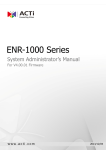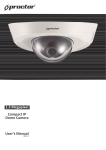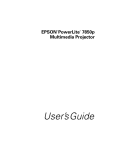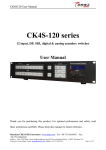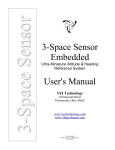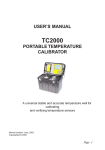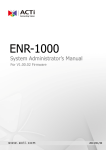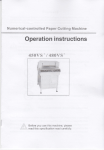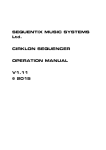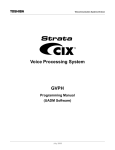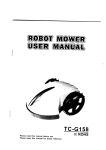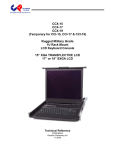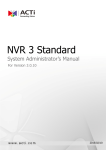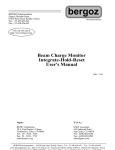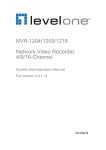Download English
Transcript
ENR-2000 Series System Administrator’s Manual For V3.02.01 Firmware 2013/07/17 ENR-2000 Series System Administrator’s Manual Legal Notice Disclaimer The information contained in this document is intended for general information purposes. ACTi Corporation shall not be liable for errors contained herein or for incidental or consequential damages arising from the furnishing, performance, or use of this manual. The information contained herein is subject to change without notice. The English version of this document is the official one for all purpose. All the translated versions are provided as a convenience. Any discrepancies or differences created in the translations of any other languages are not legally binding. Copyright Copyright © 2003-2013 ACTi Corporation All Rights Reserved. Trademarks ACTi Connecting Vision and its logo are registered trademarks of ACTi Corporation. Microsoft® and Windows® are registered trademarks of Microsoft Corporation. All other product or company names mentioned in this document may be trademarks or registered trademarks of their respective owners. 2 www.acti.com ENR-2000 Series System Administrator’s Manual Regulatory Compliance Information Federal Communications Commission Statement This equipment has been tested and found to comply with the limits for a Class B digital device, pursuant to Part 15 of the FCC Rules. These limits are designed to provide reasonable protection against harmful interference in a residential installation. This equipment generates, uses and can radiate radio frequency energy and, if not installed and used in accordance with the instructions, may cause harmful interference to radio communications. However, there is no guarantee that interference will not occur in a particular installation. If this equipment does cause harmful interference to radio or television reception, which can be determined by turning the equipment off and on, the user is encouraged to try to correct the interference by one or more of the following measures: - Reorient or relocate the receiving antenna. - Increase the separation between the equipment and receiver. - Connect the equipment into an outlet on a circuit different from that to which the receiver is connected. - Consult the dealer or an experienced radio/TV technician for help. WARNING: Changes or modifications to the equipment that are not expressly approved by the responsible party for compliance could void the user’s authority to operate the equipment. European Community Compliance Statement This product has been tested and found to comply with the limits for Class B Information Technology Equipment according to European Standard EN 55022 and EN 55024. In a domestic environment, this product may cause radio interference in which cause the user be require to take adequate measures. 3 www.acti.com ENR-2000 Series System Administrator’s Manual About This Manual Target Audience This manual is intended for System Administrators who are responsible for installing and setting up video surveillance system. The reader is expected to know the fundamentals of IP surveillance system integration and to own the administrative privileges to install and configure all the devices. You may also check the product page for updates and documents. http://www.acti.com/product/category/Standalone_NVR Technical Support If you have any questions during system installation, please feel free to contact our engineers via our Customer Help Desk platform http://www.acti.com/CHD. 4 www.acti.com ENR-2000 Series System Administrator’s Manual Table of Contents 1 Legal Notice 2 Disclaimer 2 Copyright 2 Trademarks ............................................................................................ 2 Regulatory Compliance Information .................................................... 3 2 About This Manual 4 Target Audience .................................................................................... 4 Technical Support .................................................................................. 4 3 Table of Contents 5 4 Introduction 9 Product Overview .................................................................................. 9 ENR Server / Client Architecture ........................................................... 9 Remote Client PC Requirements ......................................................... 10 Display Video Performance ................................................................. 11 Local Client - Live View / Playback .............................................. 11 Remote Client - Live View ........................................................... 12 Remote Playback ......................................................................... 12 Supported Video Format ..................................................................... 13 5 Get Started 14 What’s in the Box ................................................................................ 14 At A Glance ......................................................................................... 15 Front Panel .................................................................................. 15 Rear Panel ................................................................................... 15 Power Button & Reset Button ............................................................. 16 Turn On the Device ...................................................................... 16 5 www.acti.com ENR-2000 Series System Administrator’s Manual Turn Off the Device ...................................................................... 16 Reset to Factory Default .............................................................. 17 LED Indicators ...................................................................................... 17 6 Installation 18 Prepare the Devices ............................................................................. 18 Cameras ...................................................................................... 18 Monitor ......................................................................................... 19 USB mouse & Keyboard .............................................................. 19 USB Mass Storage Device .......................................................... 19 Hard Disks ................................................................................... 19 Install the Hard Disks .......................................................................... 20 Step 1 Remove the Tray .............................................................. 20 Step 2 Mount the Disk ................................................................. 21 Network Connection Architecture ...................................................... 22 LAN 1 Port ................................................................................... 22 Connection Setting Example 1 .................................................... 22 LAN 2 Port ................................................................................... 23 Connection Setting Example 2 .................................................... 23 Connect the Devices ............................................................................ 24 Quick Setup ......................................................................................... 25 Step 1: Log in to ENR .................................................................. 25 Step 2: Format the Hard Disks .................................................... 26 Step 3: Add Cameras .................................................................. 26 Log In/ Out ENR ................................................................................... 27 Log In ........................................................................................... 27 Change UI language 27 Remember Login Information 27 Set Auto Login 27 Live Page UI Overview ......................................................................... 28 Input Devices ....................................................................................... 29 Keyboard ..................................................................................... 29 Mouse Settings ............................................................................ 30 Software Keyboard Settings ........................................................ 30 Set Cameras ......................................................................................... 31 Add Cameras ............................................................................... 31 Auto-Add 32 Search ......................................................................................... 33 6 www.acti.com ENR-2000 Series System Administrator’s Manual Add Cameras Manually 34 Copy Camera Settings................................................................. 35 Delete Cameras ........................................................................... 36 Change Camera Settings ............................................................ 36 Configure PTZ Preset Points ....................................................... 38 PTZ Panel Description 39 Network Settings................................................................................. 40 Configure LAN1 Settings ............................................................. 40 Turn On/Off the DHCP Server 40 Configure LAN2 Settings ............................................................. 41 Set the Port .................................................................................. 41 Date & Time ......................................................................................... 42 Setup Manually ............................................................................ 42 Synchronize with Time Zone ....................................................... 42 Email Settings ...................................................................................... 43 Disk Management ............................................................................... 45 Storage Device Types .................................................................. 45 Format Hard Disks ....................................................................... 46 Schedule Recordings ........................................................................... 47 Event-Recording File Length ....................................................... 48 Set the Recording Schedule ........................................................ 48 Set the Event Schedule ............................................................... 49 Copy Schedule ............................................................................ 49 Event Management ............................................................................. 50 Event-Handling Schedule ............................................................ 50 Setup Event Rules ....................................................................... 52 Clear Event Rules ........................................................................ 54 Copy Event Rules ........................................................................ 55 User Group Management ................................................................... 56 Add a Group ................................................................................ 56 Edit / Delete a Group ................................................................... 57 Add a User ................................................................................... 57 Edit / Delete a User ..................................................................... 58 Upgrade Firmware .............................................................................. 59 Backup / Restore Settings .................................................................... 60 Backup ......................................................................................... 60 Restore ........................................................................................ 61 Customize Live Screen Layout ............................................................. 62 Change Channel Position ............................................................ 62 7 www.acti.com ENR-2000 Series System Administrator’s Manual Change Layout ............................................................................ 62 Execute Sequence Patrol ............................................................ 63 Customize System Language............................................................... 64 Modify the Wording ...................................................................... 64 Restore the Wording .................................................................... 65 8 www.acti.com ENR-2000 Series System Administrator’s Manual Introduction Product Overview ACTi ENR-2000 Series (hereafter referred to as ENR) is a compact, delicate and reliable multi-channel standalone NVR. It features a stable embedded Linux operation system and capabilities of supporting mega-pixel resolution H.264 streaming, an HDMI output for local display, PTZ control, scheduled / event-triggered / event speed-up recording, event management, synchronized playback, time/event-based playback search and video bookmarks. Its smart Setup Wizard and intuitive user interface allow the system installer enjoy effortless plug&play installation experience, while making it easy for new users to get acquainted with the operation by first-time use. Other than the local client, the remote PC client may access the ENR system simultaneously, and experiences user-friendly web interface customized for browser-based operations. ENR Server / Client Architecture In a video surveillance system architecture, ENR Server serves as a video management service provider, aimed to run 24/7 non-stop service for clients. An ENR Client makes requests of monitoring video streams or playing back recordings to ENR Server. There are two types of ENR Clients: Local Client and Remote Client. A client, connecting from whether a remote computer or from local, will be offered the same accessibilities of ENR functions. Local Client: In local camera site, the client user directly operates ENR Server by connecting the physical device to an HDMI monitor and a USB mouse. Remote Client: Over the TCP/IP network, the Remote Client communicates with ENR Server through HTTP Protocol. This client user will have to use a computer with Internet Explorer to access the ENR Server web interface, without the need of installing any client program beforehand. Logging in to ENR Server is as simple as visiting a website. 9 www.acti.com ENR-2000 Series System Administrator’s Manual Remote Client PC Requirements ENR itself is a self-contained unit. The table below provides basic guidelines only for selecting proper hardware for the remote PC client. As the decoding of multiple channels requires good hardware for smooth performance (*1), if your live view performance is not satisfactory, please consider computers with more advanced spec. PC Spec (*2) CPU Processor Minimum Requirement Intel Core 2 Quad 2.66 GHz RAM Network Operation System 4GB (*3) Ethernet (1000 Base-T recommended) Windows 7 and Windows 8 ( All versions) (*4) Display Resolution Browser 1080p Internet Explorer 9.0 and 10.0 *1 The quality of video display performance lies not only in the hardware but a few variables. Please refer to Display Video Performance on page 11 for instructions on how to achieve ideal video performance. *2 PC Spec requirements are the same for 32-bit and 64-bit systems. *3 Microsoft Windows operation system has limits on memory and address space, regardless of the real or virtual memory available on a particular computer. Please use 64-bit system if your computer has more than 4GB RAM. *4 Please make sure your operation system is fully patched with the latest service packs. 10 www.acti.com ENR-2000 Series System Administrator’s Manual Display Video Performance For a single Live View or Playback session, the way ENR handles displayed video varies based on the combination of the following factors, which you should put into consideration when configuring your view layout: (1) The number of concurrent displayed channels (2) The format of video stream, e.g., resolution and frame rate. To balance system loading, ENR will decode only I frames (*1) for viewing when CPU usage is critical. The video stream is still recorded at its original frame rate no matter at what quality it is displayed. To acquire good video display quality, however, it is suggested that you try to use the layout containing just enough channels, or make use of Sequence Patrol function. Local Client - Live View / Playback On local viewing, ENR determines when to enter Decode-I Mode according to these key references - your selection of “Layout” and the Video Resolution. A layout consisting of more channels and high-resolution streams are considered more CPU consuming, which is more likely to trigger Decode-I Mode. For example, by switching the live view layout from 4x4 style (16 channels) to Quad style (4 channels), the video will appear much smoother. 11 22 44 99 1122 1166 66 88 1133 66 1100 On a local Live View or Playback view, the conditions below ensures the live streaming to be displayed at a smooth quality(12~30 FPS); otherwise, ENR will decode only I-frames for each channel. *1 Layout Style Maximum video resolution 1, 2, 4, 1+5, 2+4, 1+7 (*2) 1280 x 720 pixels (*3) A video sequence is composed as a series of GOP (Group of Pictures). Among these pictures, I-frame (Intra-coded picture) is a fully specified picture with complete image information, while P-frames and B-frames hold only partial image information. *2 ENR will automatically turn all channels into Decode-I Mode when the number of layout channels is more than 8. *3 ENR will automatically turn any channel into Decode-I Mode when its video resolution is above 1280 x 720 pixels. 11 www.acti.com ENR-2000 Series System Administrator’s Manual Remote Client - Live View Aside from various operational scenarios, the hardware specifications of each remote client computer differ. By default, ENR system will observe the outcome of all the variables – dynamic CPU loading, and make adaptations. You may select a desired display mode to suit your system condition. On remote Live View interface, click “Application” and select “Decode I-frame” or “Auto Drop Frame”. Mode Scenario Decode I mode Auto drop Frame mode (Default) ●For For computers with basic specifications computers with advanced specifications ●For computers dedicated for displaying ENR Live View Purpose Rule Saving as much CPU usage Displaying as many video frames as as possible for other tasks possible to achieve smooth video operated on this client PC performance. Decodes I frame only Whenever the CPU loading exceeds 80%, random channels will start to decode I frame for about 15 seconds, and then return to original frame rate later. This process will continue until ●The CPU loading drops under 80% ●User switches to another layout or page. Remote Playback Up to 4 channels synchronized playback is allowed on a single remote client session, where all video frames are displayed no matter which layout is used. 12 www.acti.com ENR-2000 Series System Administrator’s Manual Supported Video Format As 1080p HDMI monitors have become the most extensive products used in various applications, ENR is designed to conform to this display standard with its capability of outputting 1080p video stream. Therefore, to reserve as much computing power for ENR unit as possible, only up to 2 megapixel H.264 video stream can be displayed on local Live View or Playback. With a client computer, you may still acquire full support for displaying these types of video codec – MPEG4, MJPEG and H.264, and up to 5 megapixel video resolution from web client interface; also, the video stream is recorded at your desired format despite of the local display limitation. Codec Resolution Camera Management Export / Recording MPEG4 MJPEG H.264 (*1) Local Live View /Playback Up to 2592 x 1944 pixels Up to 1920 x 1080 pixels (*3) H.264 (*2) Remote Live View / Playback MPEG4 MJPEG H.264 Up to 2592 x 1944 pixels *1 ENR’s “Auto Add” function will only add H.264 video stream. *2 H.264 is the only displayable codec for local live view and playback. The channels using other codec will appear blank, although the recording is proceeding normally. *3 The display of more than 2 megapixel resolution video is not supported on local live view and playback. The channels using higher resolution video stream will appear blank, although the recording is proceeding normally. 13 www.acti.com ENR-2000 Series System Administrator’s Manual Get Started What’s in the Box This product package includes the following items: 2 3 1 Quick Installation Guide Power Cord 5 4 Disk ENR Screws USB Mouse Server Item Description 1 ENR server x 1 2 Printed quick installation guide x 1 3 Power cord x 1 (Plug type varies by region) 4 Hard disk screws x 8 5 USB mouse x 1 14 www.acti.com ENR-2000 Series System Administrator’s Manual At A Glance Front Panel Rear Panel 15 www.acti.com ENR-2000 Series System Administrator’s Manual Power Button & Reset Button You can turn on/ off the device with Power Button. Turn On the Device Press down the Power Button and release, the Power LED will light up and turn solid blue. Turn Off the Device As the device is powered on, the Power LED and System LED are both lit, and the Power Button is in pressed state. To turn ENR off, please do the following: 1. On Live screen, click Setup Power tab, and click “Shutdown”. 2. The local display screen will turn black, with an information dialogue box showing up. Please observe the System LED on front panel, when its orange light is off, you may press the Power Button to completely shut down the device. 16 www.acti.com ENR-2000 Series System Administrator’s Manual Reset to Factory Default By resetting this device, all your system settings will return to factory default, while the previous recording files are still kept on storage disks. It is strongly recommended that you back up previous settings with Backup function before resetting to factory default. 1. To begin, please turn off the device first. 2. Press down the Power Button to boot up the device, immediately press and hold the Reset Button with a pin or clip, the orange System LED will light up for about 2~3 seconds, and you may release the Reset Button as the orange light is off. The device will then start the resetting process. After the device automatically reboots, the resetting process is done and you may log in. LED Indicators The LED indicators on front panel show the current device status: Item Power LED Indicator Status Solid Light Color Blue Lights up for three System Status LED seconds after Reset Button is pressed Flashing The device power is on. The system resetting process is Orange Solid HDD LED Description initializing. The system service is running. Orange 17 The hard disk is busy handling read or write requests. www.acti.com ENR-2000 Series System Administrator’s Manual Installation The installation procedures may vary depending on your site conditions. The procedures provided in this manual are based on an example condition consisting of (1) local network, (2) an ENR unit, (3) ACTi network cameras, (4) a POE network switch and (5) necessary peripherals. Prepare the Devices Before starting connecting all the devices together, please read the instructions below to make sure your devices are ready for ENR system. Cameras ENR is able to automatically add the connected cameras then immediately displays their live streams without your further configurations. It is strongly recommended that you return the camera settings back to factory default beforehand. Otherwise, please fulfill the conditions below to make sure your cameras are prepared for ENR Auto Add function: 1. For cameras whose settings have been changed from factory default, please make sure the camera output stream’s encoder type is H.264, (2) the camera’s IP address falls in the same network range with ENR LAN1 port:192.168.0.10 or LAN2 port (DHCP). 2. Individually configure other camera properties via camera’s web configurator with another PC if required, for example, the Video Motion Region Settings, Stream Mode, etc. 3. To have ENR automatically assign IP addresses to cameras via LAN 1 port, make sure the camera connection type is Dynamic mode (DHCP Client). ( ACTi camera web configurator interface) 18 www.acti.com ENR-2000 Series System Administrator’s Manual Monitor The monitor should supports HDMI port and 1080p full HD resolution display. USB mouse & Keyboard Please use a USB mouse or keyboard with a cable. USB Mass Storage Device The USB mass storage device is required for system backup and system log / snapshot / video export. ENR supports all FAT/FAT32/EXT2/EXT3/EXT4/NTFS file systems. Hard Disks For video recordings, you should install at least ONE certified 3.5-inch SATA hard disk. Please always use the hard disks ACTi tested to be compatible with ENR. You may find the certified models in this document ACTi Certified HDD List for Standalone Network Video Recorders available via this web link: http://www.acti.com/hdd. 19 www.acti.com ENR-2000 Series System Administrator’s Manual Install the Hard Disks This system requires at least one hard disk to store video recordings and firmware image when upgrading system. Please follow the instructions below to install your hard disks in correct order to make sure the physical disk locations accord with the Disk ID shown in ENR server’s Storage Device List. To start, TURN OFF THE DEVICE, open the front cover, repeat the following steps to install the hard disks into the disk bays. Step 1 Remove the Tray Slide the Lock Tab to the right, the Hinge Tab will pop out by itself. Remove the four front panel screws, and then remove the three back panel screws. Pull the Hinge Tab to 90 degrees from the front, and pull out the tray. 20 www.acti.com ENR-2000 Series System Administrator’s Manual Step 2 Mount the Disk Mount the disk by locking it with supplied disk screws to the bottom of the tray. Step 3 Install the Tray Press on Lock Tab, push the tray into the bay until it stops. Finally, close the Hinge Tab. 21 www.acti.com ENR-2000 Series System Administrator’s Manual Network Connection Architecture When connecting ENR with your network, please make sure you plug the network cable into the right port. LAN 1 Port (Camera Port) Default: 192.168.0.10 LAN 2 Port (WAN Port) Default: Dynamic /192.168.1.10 LAN 1 Port LAN 1 port is the default camera port for a typical local network. Via this port, the DHCP server built in ENR automatically assigns IP addresses to network cameras once they are connected. With this feature, you do not have to bother arranging the camera IP addresses on your own. By default, this DHCP server is enabled, so please avoid connecting ENR to a network where exits another DHCP server via this port. Connection Setting Example 1 Below diagram displays an example connection setting using only LAN1 to connect networks cameras. In this setting, ENR altogether with cameras are within the same network segment; in the mean time, there is no need of referencing outside DHCP server in this system. LAN 1: 192.168.0.10 192.168.0.101 ~ 192.168.0.104 22 www.acti.com ENR-2000 Series System Administrator’s Manual LAN 2 Port LAN2 port is a typical Ethernet port. You will have to use this port to connect with a different network segment when your system requires (1) the connection with a remote PC client or network cameras, (2) the use of event-triggered Email service via external SMTP server (3) the use of date/time synchronization with external NTP server. By default, once connecting to a network, it will first try to get an IP address assigned by your network router from DHCP server. If your network does not assign IP address automatically, then LAN2 port will assume IP address 192.168.1.10. Please note that every time you connect a network via LAN2, you have to REBOOT ENR to refresh the IP addresses. Connection Setting Example 2 Below diagram displays an example connection setting using LAN1 + LAN2 to connect networks cameras within different network segments. In this setting, ENR with three cameras are within the same network segment, while there is another camera locating in another network. In addition, this system requires the connection with an external SMTP server and a remote client. SMTP Server LLA AN N 11:: 119922..116688..00..1100 Remote PC Client LAN 2: DHCP client (ex:172.16.26.100) DHCP client (ex:172.16.26.101) You may check and modify the network configurations by going to Live View Menu Select “Setup Menu” click System Settings tab, and select Network.( for detailed configuration instructions, please refer to Network Settings on page 40). 23 www.acti.com ENR-2000 Series System Administrator’s Manual Connect the Devices Follow the procedures to connect the devices. These devices are supposed to get connected in the sequence shown below. 1. Plug the power adapter into ENR and electricity outlet. 2. Connect the HDMI monitor. 3. Connect the USB devices. 4. Press down Power Button. The power status LED will turn solid blue. 5. Attach the network cables to LAN1 Port. 6. Connect the network cameras to the switch and power them on. 7. Attach the network cables to LAN2 Port. (optional, required for the access to another network) 24 www.acti.com ENR-2000 Series System Administrator’s Manual Quick Setup By the first time you log in to ENR, the Setup Wizard with bring you through the initial setup process. Step 1: Log in to ENR After the device starts, you will first see ACTi splash screen then system interface. On Login window. Click into the Account and Password fields to enter the default account information - admin / 123456, then click “Login”. 25 www.acti.com ENR-2000 Series System Administrator’s Manual Step 2: Format the Hard Disks At present, the hard disks you installed in ENR are not ready for recording, they need formatting before use. On HDD setup wizard window, select the unformatted disk and click “Format”. Repeat this step to format the other disk, and then click “OK”. As ENR has successfully formatted a hard disk, a message will pop out to notify you. Step 3: Add Cameras Please select Auto Add, this function will add the Stream 1 of detected cameras and display them on Live screen right away. 26 www.acti.com ENR-2000 Series System Administrator’s Manual Log In/ Out ENR By default, an administrator account has already been existing in your system. To log into ENR system for the first time, you will have to key in the password in Login window. Log In If you are not logged in yet, click on screen to bring up the Login window. A B C A To change UI language,1select the desired language from “Language” dropdown list. Change UI language Remember Login Information B To have the server remember your Account, Password and language setting for future, check “Remember me”. Set Auto Login C Check “Remember me” then “Auto Login”, you will skip the Login page and directly enter Live View screen when accessing ENR in the future. This feature makes using ENR more convenient, however it may pose a security risk because any other user can enter ENR using the account you established. The Remember me and Auto-login function will be cancelled when you logout from ENR. Log Out On Live Menu, click “Logout NVR” . 27 www.acti.com ENR-2000 Series System Administrator’s Manual Live Page UI Overview After logging in , you will enter Live page. Live monitor is the interface where you see the live views from your cameras. It is where most of the security professionals access the surveillance system A B Live view display area C D F E G No Description A Camera List: Lists all the cameras in this system and their recording status. Event List: Displays alerts of detected motion, recording and conneciton status. PTZ Control Panel Provides live view onscreen PTZ controls. This panel is only enabled when a PTZ camera channel is selected on live view display area. System Status: Displays the following system status from left to right – (1) connected USB storage device, (2) total free disk space, (3) LAN1 IP address, (4) LAN2 IP address, (5) your user account and (6) current system time. System Message Displays import message to inform you of certain system conditions that require your prompt action. Live Menu Lists available layout selection and live view operation controls Page Switch You may switch to the Setup or Playback page by clicking the tags. The Setup page is only accessible from Live page. B C D E F G 28 www.acti.com ENR-2000 Series System Administrator’s Manual Input Devices The input devices are ready to use when you connect them to ENR via USB ports. Keyboard The onscreen keyboards allow you to input characters without using a physical one. By clicking in a character field (e.g. Account or Server name) or number field (e.g. IP address or Port), the specific onscreen keyboard will be brought up. Standard Alphabet + Symbol Keyboard Number + Symbol Keyboard Symbol Keyboard 29 www.acti.com ENR-2000 Series System Administrator’s Manual Mouse Settings You may adjust the mouse’s cursor speed via the path below: On Live screen, click Setup select System tab click “Mouse”. Software Keyboard Settings To disable the virtual keyboard if a physical one is already in use, on Live screen, click Setup select System tab click “Keyboard”. Uncheck the box “Always shows software keyboard”. 30 www.acti.com ENR-2000 Series System Administrator’s Manual Set Cameras ENR user interface also allows you to easily configure or copy camera setting, add or delete cameras without the use of another web browser. Add Cameras On Live page, click Setup Camera tab. There are three methods you can use to add cameras: (A) Click Search to scan through the available video sources, and select desired cameras to add by yourself. (B) Click Auto Add to let ENR add the channels automatically. (C) Fill in the properties in this area to Manually add one. A B C V Note ENR will synchronize with devices upon connecting to them. To make sure the settings on ENR side are prior to and always overwrite those on camera sides, please check “Auto save ENR settings into device upon connection”. 31 www.acti.com ENR-2000 Series System Administrator’s Manual Auto-Add This is strongly recommended for a quick system setup. As all your required cameras have connected to the system, ENR will look for Stream 1 of each camera, add them to the Camera List and display their live streams on the Live screen immediately. Input the User Name and Password to access the camera (this user account must be the camera’s root account) and click “OK”, a message will pop up to tell you the cameras have been added successfully. Live page will display the live streams and start full-time recording right away. Note If your camera is set to Dual Stream mode, Auto Add function will add only Stream 1; for a 4VGA or 6VGA stream mode camera, all Stream 1 ~ Stream 4 will be added. 32 www.acti.com ENR-2000 Series System Administrator’s Manual Search This search method is recommended when the cameras within the network outnumber the required number of channels for this ENR. By performing Search, you will be provided with a list of all available cameras. You may select any desired stream to add to your system. Input the User Name and Password to access the camera (this user account must be the camera’s root account) and click “OK”. After a while, the search result will pop up, select your desired cameras/streams, and click “Add”. H A B C D E F G I No A Column Name B C IP Address Channel D E Compression Resolution Description The camera models will be listed in alphabet order based on their model names. Camera IP Address Represents the camera’s stream ID. For example, only channel 1 (stream 1) will be detected from a single stream mode camera; while both channel 1 (stream 1) and channel 2 (stream 2) will both be detected from a dual stream mode camera, and so forth to a 4VGA or a 6 VGA mode camera. Video compression Camera image resolution 33 www.acti.com ENR-2000 Series System Administrator’s Manual F G Frame Rate Status H Search I Add Video frame rate Blank: this camera is accessible and not added yet. In Use: this camera/stream has been added to the system. Inaccessible: this camera is inaccessible. You will have to try accessing it using another Username or Password, (make sure this account is that camera’s root account), and click Search again. After Username and Password fields are filled in, click this button to perform the search. After selecting your desired cameras/streams, click this button. The selected video sources will be added to Live channels Please note that your clicking order will decide Live View channels arrangement. For example, you select cameras on the search list in this order: TCM-4511 TCM-5111 D11 E52, which will exactly become the camera order: 1.Camera 2.Camera 3.Camera 4.Camera Add Cameras Manually If you have known certain camera’s connection properties, you may add it manually. 1. Select a Camera ID, from the Camera List on the left. 2. Fill in the connection properties such as properties IP Address, Port, Username and Password, and click “Get Camera Settings”. 3. The camera settings will appear. Click “Save” to save it to this camera channel. 1 2 34 www.acti.com ENR-2000 Series System Administrator’s Manual Copy Camera Settings You may copy an added camera’s settings another channel. In this way, it is easier to manually add more than one camera of the same models. 1 3 4 2 35 www.acti.com ENR-2000 Series System Administrator’s Manual 1. Select an existing channel. 2. Click “Duplicate”, a target channel list will pop up. Select your desired target caneras and click “Duplicate”. In the example shown above, Camera 1 properties will be copied to 2. Camera and 3.Camera. Delete Cameras You may delete a single channel one at a time or delete them all at once. The deletion of certain channel will not include the previous recordings of it. 1. Select an existing channel. 2. Click “Delete to delete the selected channel or “Delete All” to delete all channels. 1 2 Change Camera Settings After the cameras are added, you may change their properties on Camera tab. Before saving the changes, you should always click “Get Camera Settings” then click “Save”. There are two types of properties you can modify: connection properties and camera properties. To modify the connection properties including camera Name (maximum length is 24 characters), IP address, HTTP Port, User Name and Password, simply edit the value in the fields , click “ Get Camera Settings” and “Save”. 36 www.acti.com ENR-2000 Series System Administrator’s Manual 1 2 3 To modify the video settings including Channel ID, Resolution, Frame Rate, Protocol, and Bitrate, you will have to click “Get Device Settings” first to sync with the cameras first, then edit the value in the fields and click “Save”. 1 2 3 If you have to change certain settings that are not available on ENR interface (e.g. video motion region settings, stream mode) for a saved channel, please do the following, 37 www.acti.com ENR-2000 Series System Administrator’s Manual 1. Uncheck the “Auto save ENR settings into device upon connection”. 2. Via camera’s web interface, change the camera settings, you will have to use a computer to do this. 3. On ENR Camera settings page, click “Get Camera Settings”, ENR will apply the current camera settings. 4. Click “Save”. Configure PTZ Preset Points 1. On Live screen, select the PTZ channel on display area. 1 2 2. Click the PTZ Panel tag to open the panel. PTZ Panel 38 www.acti.com ENR-2000 Series System Administrator’s Manual PTZ Panel Description No A A B B C D C E F G D H E F G H 3. Function 8 directional arrow keys: Click to pan or tilt the camera (only available for cameras with Pan/Tilt/ capability). Pan/Tilt/Zoom speed: Click to change the speed. Provided speed scale is from 1 to 5 (available for cameras with Pan/Tilt/Zoom capability). Manual focus (Available for cameras with a controllable focus) Near focus Far focus These buttons are enabled when the “Auto Focus” function is unchecked Zoom (Available for cameras with a controllable zoom) Zoom in Zoom out Auto focus (available for cameras with auto focus) Preset Points Editor Click to enter Preset Points edit mode. Tour Mode Click to enter Tour mode. Before enabling a tour, you will have to edit and save the Preset Tour via camera web configurator in advance. Preset Points Click to the Preset Point ID to make the camera point to the pre-defined position. On PTZ Panel, click to enter Preset Points Editor. 4. Use buttons A ~ E on PTZ Panel to define a view, then click the desired preset point ID, this preset point will be saved, and this pint ID will become red. 5. To delete a point, simply click and the preset points you want to delete. 6. After editing, click will save the setting and exit the editor mode. 39 www.acti.com ENR-2000 Series System Administrator’s Manual Network Settings You may check the network adapter setting of LAN1 and LAN2 via the path: Live page Select Setup click “System” tab click “Network”. If you have done any change on LAN1, LAN2 or Port Mapping tab, be sure to click “Save” before you leave this page. Configure LAN1 Settings As LAN1 port supports only DHCP server function. Without the DHCP client capability, it cannot get IP from another DHCP server, and you will have to define its IP Address and Subnet Mask manually if necessary. The default IP is 192.168.0.10. Turn On/Off the DHCP Server By default, the DHCP server is enabled. It will assign IP addresses to the cameras which are in DHCP (client) mode. You may also define the range of assigned IP address. Simply enable the DHCP Server by checking the box “Enable DHCP Server”, fill in the beginning IP address in Start IP Address field, and the ending IP Address in End IP Address field. The default range is 192.168.0.101~192.168.0.200. 40 www.acti.com ENR-2000 Series System Administrator’s Manual Configure LAN2 Settings LAN2 port is originally in DHCP (client) mode. If LAN2 cannot obtain an IP address from the DHCP server, it will change to Static mode. In Static mode, the default IP is 192.168.1.10. Set the Port Change the ENR Port here if you have setup port forwarding service for ENR’s IP. 41 www.acti.com ENR-2000 Series System Administrator’s Manual Date & Time ENR provides three methods to synchronize the time setting; you can (1) manually set the date and time, (2) sync with Time Zone or (3) synchronize with NTP server. On Live screen, click Setup click System tab click “Date and Time” 1 2 3 Setup Manually In Date & Time section, click the button that shows date and time information on it. On the popped-out calendar, select the correct date and time, then click “OK”. Synchronize with Time Zone In Time Zone section, select your zone from the Time Zone drop-down list. If your time zone falls in Daylight Saving Time area, you may check the box “Enable Daylight Saving Time”, and then system time will automatically adapt itself to daylight saving time clock. Synchronize with NTP server In NTP Server section, fill in the NTP server IP or domain name in the NTP Server field, and click “NTP SynC” to start synchronizing, and then click “Save” to save this setting. 42 www.acti.com ENR-2000 Series System Administrator’s Manual Email Settings ENR supports email notification for Event Handling sent through an SMTP server. To enable this service, you will have to configure the SMTP mail settings in advance. In order to reach out to an SMTP server, your network cable should go through ENR LAN 2 port which communicates with a network other than ENR local network. 1. On Live screen, click Setup Select System tab click “Email” 1 2 3 4 2. Fill in every field according to the detailed instructions in the table below. 3. Click “Send Test Mail” to send a test mail to this email account. If the test mail is sent successfully, the dialog box below will pop up, which means your ENR server is ready to send out email notifications when being triggered by an event. 4. Click “Save” to save these properties. Field Name Description Sender Email Input the sender’s email address, should the same account you set for SMTP server. Server Input the sender’s SMTP server address. Only alphabets, numbers, and the 43 www.acti.com ENR-2000 Series System Administrator’s Manual symbols (.), (_), (-) are valid. ENR server supports the SMTP services with SSL protocol. If you wish to use a free webmail SMTP service, you may choose certain webmail providers such as Yahoo (SMTP: smtp.mail.yahoo.com Port:25) or Gmail (SMTP: smtp.gmail.com Port:25 or 465 for SSL protocol / 587 for TLS protocol) Port Set the SMTP port, allowed value is from 1~65535, default is 25. Account Input the name of the SMTP server account. The form of account name depends on mail server, e.g. a Hotmail account name is a complete email address, while other mail servers’ are not. Only alphabets, numbers, and the symbols (@), (.), (_), (-) are valid. Password Input the password of the SMTP server account. Only alphabets and numbers are valid. 44 www.acti.com ENR-2000 Series System Administrator’s Manual Disk Management ENR keeps the recordings on SATA hard disks installed in it. Whenever recording is taking place, ENR writes data to one of the disks, and switch to the other as the original one is full. Once the available space of the whole system is less than the reserved size, ENR will start deleting the oldest file to make the amount of space allowing each active channel to record for another 10 minutes. You may observe the disk memory and recording status on Storage page. On Live screen, click Setup click Maintenance tab click “Storage”. The connected storage devices will be shown in the Storage Device list. Select a storage device to check its Storage Information appearing as below. Storage Device Types ●SATA1 represents the disk installed in upper bay for saving recordings. ●SATA2 represents the disk installed in lower bay for saving recordings. ●Storage Media represents the connected USB disk that you use for carrying firmware image file, backup file, exported system log file, snapshots or video. 45 www.acti.com ENR-2000 Series System Administrator’s Manual Format Hard Disks You may execute disk formatting toward a newly-installed disk. You should follow the installation procedures ( refer to Install the Hard Disks on page 20 ) to format the disks before ENR system start carrying out the surveillance task, for a disk that is not in ENR file system format is not ready for recording. After the disk is installed and detected in Storage Device list, select it and click “Format”. During normal operation, please DON NOT REMOVE ANY DISK FROM THE DEVICE, or it might cause damage to the disks. You can only remove or install a disk when the device is shut down. If you have to format a disk having been recording for a while, it is suggested that you export important video and system log in advance. Please note that the system will stop recording during the disk formation. 46 www.acti.com ENR-2000 Series System Administrator’s Manual Schedule Recordings Unlike the traditional analog surveillance system, the IP surveillance system provides a target-oriented recording schedule for devices; the view of each device can be recorded based on your required time segments and event types. For example, you may have a camera installed on the office ceiling do continuous recording during work hours, and record only upon the triggers (incidents that detected by system) at night. In this way, the system does not waste disk space storing meaningless parts, and you save lots of effort browsing playback for specific events. For the recording schedule, ENR supports Schedule recording, Event recording and Event Speed-up Recording modes, which are set up on a week-based timetable; the event-handling schedule is configured here. On ENR, you can configure camera’s recording schedule on 7 days / 24 hours basis. The schedule is split into segments of one-hour-length. By default, once a device is added to the system, its schedule is automatically set to full-time schedule recording and event handling. You should configure it according to your system plan. On Live screen Select Setup click “Schedule” tab and select one channel. 47 www.acti.com ENR-2000 Series System Administrator’s Manual Event-Recording File Length Before setting the recording schedule, you may define the length of an event recording. To do this, configure the following properties shown as below, which will make an event recording as long as 10+30 second: Field Pre-event Recording Buffer (sec): Description ENR keeps a short cache of video received from devices. If an event is triggered, ENR will automatically store the pre-event buffer along with the recording of the event itself. Post-event Recording Buffer (sec): This will determine how long after the event is triggered should be included in the event recording file. Set the Recording Schedule On the time table 1. Click on the recording mode from Field Full-Time Recording Description Continuously record at the video frame rate you define in Camera Settings. Event Speed Up Continuously record everything at 1FPS, when an event occurs, the Recording frame rate will switch to the value you define in Camera Settings, and automatically switch back to 1FPS after the event ends. Event Recording Only events are recorded, at the video frame rate you define in Camera Settings. 2. Click and drag over the “Time Track” to set time period. 3. Click “Save”. 48 www.acti.com ENR-2000 Series System Administrator’s Manual Set the Event Schedule The Event Schedule defines when the event handling is activated. To set the event rules, please refer to Setup Event Rules on page 52. on page 52 for Event Rules settings. By default, the event handling is full-time activated; you may disable it during certain time period. 1. Click on the recording mode “No Event Handling”. 2. Click and drag over the “Time Track” to set time period. 3. Click “Save”. Copy Schedule You may copy a camera’s schedule setting to other multiple cameras. This saves much your time on configuring the schedules camera by camera. 1. On Schedule tab, select a source camera from camera list, its schedule will be copied to others. 2. Click “Copy” 3. On Copy Schedule window, select the target cameras. 4. Click “Copy” on Copy Schedule window. 49 www.acti.com ENR-2000 Series System Administrator’s Manual 1 3 4 2 Event Management When something happens on camera site, such as someone walks by, the door opens or a fire breaks out – these are all Events. The event which occurs in the environment and was pre-programmed in the camera serves as Triggers. Triggers cause the device to react with Responses. The link between trigger and response is governed by Event Rules. Each event rule detects one specific trigger and may initiate multiple responses. An example rule would be for ENR to send an email to alert the manager (Response 1) and trigger the alarm (Response 2) when motion on camera site is detected (Trigger) during the event handing active period (Schedule). Each device can be involved in several event rules. As different camera models possess various capabilities, the supported response types would vary. For example, a PTZ camera can execute a go-to preset point response, while this option is not available for other models without this feature. Event-Handling Schedule Event rules become active or inactive based upon a weekly schedule, to enable event-handling service, you will have to make sure the event-handing schedule of certain device is well configured. By default, the event-handling schedule of each camera is enabled for 24 hours once it is added to ENR system. 50 www.acti.com ENR-2000 Series System Administrator’s Manual To configure the Event Handling Schedule, on Live screen, click Setup click “Schedule”, select the camera, and drag on the 24-hour time table. 51 www.acti.com ENR-2000 Series System Administrator’s Manual Setup Event Rules On Live screen, click Setup click Event tab select a camera. 1. Once a device is added to ENR server, the server would provide empty rules with compatible trigger types for you to configure such as Motion 1, Motion 2, Motion 3, DI 1, DI 2, Network Loss and Network Recovery. Select the Event Type, then click “Set”. 2. Select the trigger type: Trigger DO Set the DO to become ON or OFF upon trigger, only the devices supporting DO functions are available. Check the “Enable” to enable this function, and the device whose connected DO(s) will be triggered. You may select one DO to be activated after the other and the duration time between them. Clik “OK” to confirm. 52 www.acti.com ENR-2000 Series System Administrator’s Manual Send Mail Enable ENR to send email notifications via SMTP service.Check the “Enable” to enable this function, and fill in the mail recipient’s email address in “To” field, notification title in “Subject” field and mail body in “Body” field, then choose a camera whose snapshot will be attached from Attach a Snapshot dropdown list. Clik “OK” to confirm. Please note that if you want to attach a snapshot to the notification email, make sure your local display stays on Live screen during the event handing period, in this way, ENR can take the snapshots for motion events. To enable this service, you have to configure the Email setting ( please refer to Email Settings on page 43) before this trigger is enabled. Go to Preset For the use of PTZ cameras to make movements toward certain triggers, please configure the preset points (refer to Configure PTZ Preset Points on page 38) on Live screen before you set the event rule. On Go to Preset tab, check the “Enable” to enable this function (if there is no PTZ camera exsiting in ENR server to execute a PTZ response, a red sign would appear on the tab , please add a PTZ camera). Select which PTZ camera in ENR server to make the movement, then the preset points and duration time between them. Click “OK” to confirm. 53 www.acti.com ENR-2000 Series System Administrator’s Manual Beep ENR device can play beep sound upon being triggered by events. On Beep tab, check the “Enable” to enable this function. Input the duration time and prepeat times of the beep. Click “OK” to confirm. Enlarge Live screen will display certain channel view in full screen for a while when the system is triggered. On Enlarge tab, check the “Enable” to enable this function. Select the camera whose live view will be enlarged on Live screen and the duration time. Click “OK” to confirm. 3. After configuring the event handling rules, on Event tab, input the dwell time in for all the rules you set. Dwell Time defines, after an event occurs, the period of time during which the same event will not be triggered again. 4. On Event tab, click “Save” to save the settings. Clear Event Rules On Event tab, you may select an event rule under certain camera, and click “Clear This” to delete it, or “Clear All” to deleta all the rules belong to this camera. 54 www.acti.com ENR-2000 Series System Administrator’s Manual Copy Event Rules You may copy a camera’s event rules to other multiple cameras. This saves much your time on setting up rules one by one. 1. On Event tab, select a source camera from camera list, its rules will be copied to others. 2. Click “Copy” 3. On Copy Event window, select the target cameras. 4. Click “Copy” on Copy Event window. 1 3 4 2 55 www.acti.com ENR-2000 Series System Administrator’s Manual User Group Management In ENR, the access permissions are managed by User Groups. User Groups defines what functions are allowed for a group of users. Different User Groups will have different access rights in terms of permitted operations like monitoring Live screen or execute Playback. For example, an Administrator user is allowed for all the operations in ENR, while a standard normal user may only be permitted to do Live monitoring. On Live screen, click Setup click User tab to enter Group and User management page. Add a Group By default, the Administrator User Group with full permissions in ENR already exists. Except for the password and email settings, you may not delete this account or change its permissions. 1. Select “Group” , click “Add” to bring up Add New Group window, enter the Name and Description of the group, and click “OK” to add it to the Group List. 2. On Group List, select this group. In Group Permission section, enable the permissions possessed by this group. 56 www.acti.com ENR-2000 Series System Administrator’s Manual 3. Click “Save” to save the group settings. Edit / Delete a Group You may edit an existing group by changing its Name, Description or Permissions or delete it. Once you delete a group, the Users belonging to it will be removed altogether. Select the group on Group List, click “Edit” or Delete”. Add a User By default, the Administrator User already exists, which you may not delete. 1. Select User, click “Add” to bring up Add New User window, enter the Name, Password, Email and select its User Group from dropdown list. Click “OK” to add it to the User List. 2. Click “Save” to save the user settings. Account /Password Rules 1. Account field allows alphabets, numbers, and symbols except the following: * < > ? | “ \ :. The maximum length of characters is 15. 2. Password field allows alphabets, numbers and symbols. The maximum length of characters is 40. 3. Both the Account and Password field are non-case-sensitive. 57 www.acti.com ENR-2000 Series System Administrator’s Manual Edit / Delete a User You may edit an existing user or delete it. Select the user on User List, click “Edit” or Delete”. Please always click “Save” before leaving this page. ` 58 www.acti.com ENR-2000 Series System Administrator’s Manual Upgrade Firmware You may check ACTi corporate website for latest ENR firmware package and download it. Unzip the package and save the *.upg file to the root directory of a USB disk and insert it into ENR USB port. 1. On Live screen, click Setup click Maintenance tab select “Firmware Upgrade”. 2. Click “Browse” , find the target *.upg file and click “Open”. 3. Click “Upgrade”. During upgrading, the system will stop every other activity including recording and event handling. The system will auto-restart after the upgrading completes. After upgrading has started, DO NOTcut off the system power or eject the USB disk until ENR restarts. Please note that the USB disk carrying the firmware image should at least have 200 MB free space. 59 www.acti.com ENR-2000 Series System Administrator’s Manual Backup / Restore Settings Making regular system backups is always recommended in case of unexpected disasters or accidents that may damage ENR server. ENR server can create a backup file of the whole system settings as Backup_[yyyymmdd].nvr file and save it to a connected USB disk within one click. The backed up settings include the following properties: (1) System Settings including System Name, Date & Time, Network, Email, Mouse and Keyboard, (2) Camera Settings, (3) Schedule Settings, and (4) Event Management. The recordings will be kept on hard disks, please refer to ENR User’s Manual to export a system log file and to export video files for a complete backup. Backup To start backing up system setting, please insert a USB disk into ENR first. 1. On Live screen, click Setup” click Maintenance tab click “Settings Backup / Restore”. 2. Click “Backup”, the backup file will be saved to your USB disk as .nvr file. 60 www.acti.com ENR-2000 Series System Administrator’s Manual Restore Before starting restoring the system, make sure you have connected the USB disk with the desired .nvr backup file in it, and the backup file is saved in the root directory. 1. On Live screen, click Setup click Maintenance tab click “Setting Backup / Restore”. 2. All the .nvr file detected from your USB disk root directory will be shown on the File Name dropdown list, select your desired one. 3. Click “Restore” to start restoring the settings. The server will restore the settings from the backup file and reboot. 61 www.acti.com ENR-2000 Series System Administrator’s Manual Customize Live Screen Layout You may customize the layout style, channel position and patrol behavior. Your arrangement of Live screen layout will be the default view after any local user logs in to ENR. Change Channel Position You may place any channel in your desired window, and ENR will remember this arrangement until you change it. Select the channel, and drag to the target window. In the example below, the green numbers represent the position of windows, and Channel 1 will be swapped to Window 5. Channel 1 1 2 3 Channel 1 4 5 6 7 8 9 Toy can reset the channel positions by clicking on Live Menu. Change Layout To select a desired layout, click one in the layout selection area. Each layout will display specific windows shown below. Therefore, you have to make sure the channels you desired to watch are placed in the designated windows before applying the layout. For example, to watch Channel 2,4,6,8 in a quad layout, you should: 1. On the 3x3 layout, place Channel 2 into Window 1, Channel 4 into Window 2, Channel 6 into Window 3 ,and Channel 8 into Window 4. 62 www.acti.com ENR-2000 Series System Administrator’s Manual Channel 2 Channel 4 1 Channel 6 2 3 4 5 6 7 8 9 Channel 8 2. Select the 2x2 layout on Live Menu. Channel 2 Channel 4 Channel 6 Channel 8 Execute Sequence Patrol 1. On Live Menu, click to bring up the Patrol Time Setting window. 2. Input the patrol time 3. Click “OK”, the patrol will start until you click 63 again. www.acti.com ENR-2000 Series System Administrator’s Manual Customize System Language ENR user interface supports multiple languages and offers you the flexibility to change the wording . There are over 10 supported UI languages you may choose on Login page. Each language (except for English) is open for customization based on your own needs. This section will describe how to choose or customize language wording for your ENR. To start, you need to connect a USB disk to ENR to export the language file for editing. Modify the Wording After the USB disk is connected, 1. On Live screen, click Setup click Maintenance tab click “Language Adjustment”. 2. On Language Adjustment page, below Export Language section, select your desired language form original language file list, and click “Export”. ENR will pop up a window as the file is successfully saved to USB disk. Language file name 3. On a computer, open the file ( *.json) with a text editor program. Each entry represents the current wording of an object. Please edit the wording of your language embedded in quotation marks (“ ”) on the right of the colon; The English term appearing on the left is the original system code, which should be left unchanged. 64 www.acti.com ENR-2000 Series System Administrator’s Manual Edit here 4. After the modification is done, save this file with its original file name and file type onto the USB disk, make sure the text encoding format is UTF-8. 5. Connect the USB disk with ENR, on Language Adjustment page, select the language file from drop-down list below Import Language section, and click “Import”. ENR will pop up a window as the file is successfully imported into ENR server. 6. Log in to ENR again. On Login window, select the UI language before you click “Login”. 7. Check the UI to see if the modified term is correctly shown. Restore the Wording ENR always keeps the original language file in its memory, so you can restore the language wording to default. On Language Adjustment page, select the language file from drop-down list below Restore Language section, and click “Restore”. The entire original language wording will restore after you log into the system again. 65 www.acti.com

































































